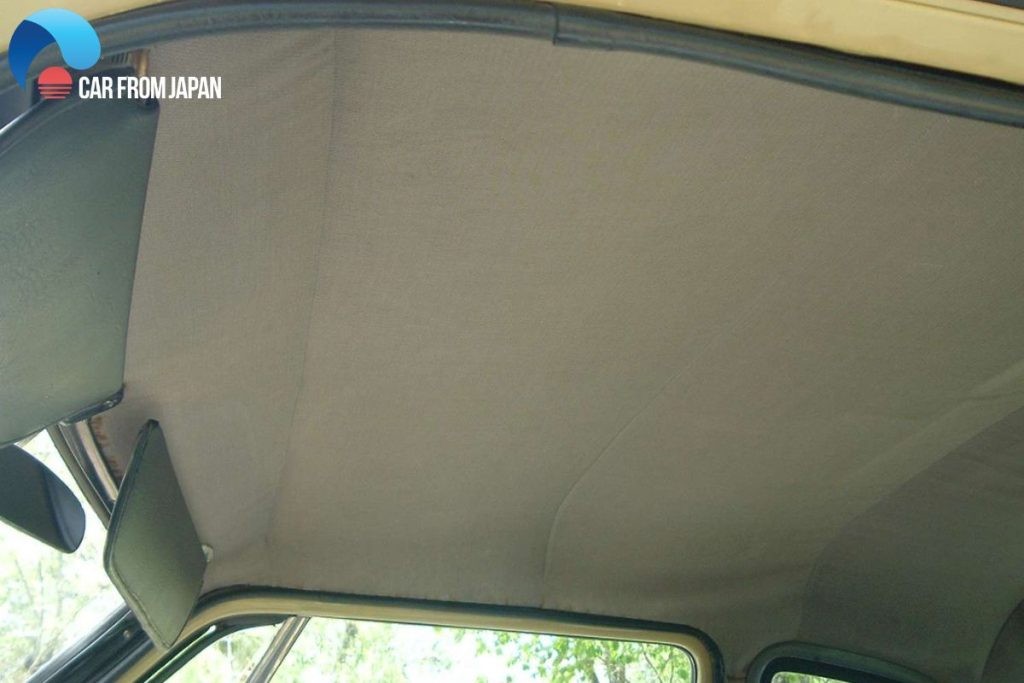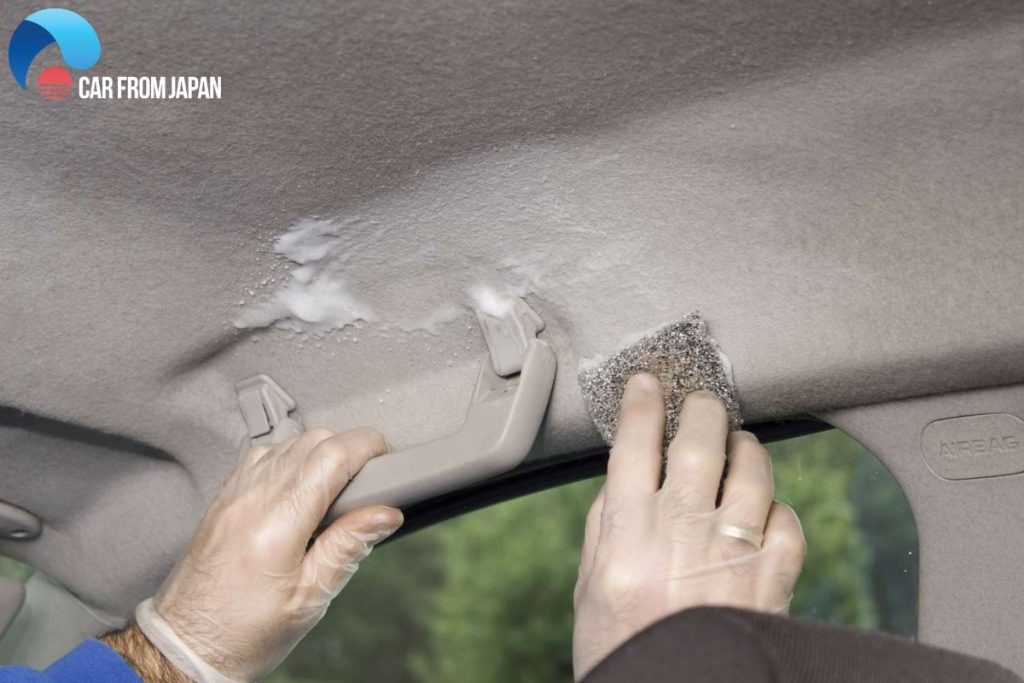A sagging car headliner is more than just an eyesore; it can detract from your driving comfort and even be a symptom of underlying issues within your vehicle. Wondering how to repair that drooping fabric without the hassle of a full removal? You’re in the right place. This guide will walk you through effective and straightforward methods to restore your car’s headliner, saving you time and money. Let’s dive in and learn how to tackle this common car interior problem.
Understanding Your Car Headliner
Before we get into repairs, let’s understand what a headliner actually is. The headliner, or headlining, is the fabric material affixed to the interior roof of your car. It’s designed to provide a finished look to the cabin, but it’s also functional. Headliners are crucial for noise reduction, absorbing road noise and vibrations, and for thermal insulation, helping to keep your car cooler in the summer and warmer in the winter.
Typically, a car headliner is constructed from multiple layers. This often includes a foam backing, commonly made of polyurethane, which is bonded to a rigid headliner board. This board is then mounted to the car’s roof frame. The foam layer adds softness and enhances the headliner’s insulating properties against both temperature and sound.
Beyond aesthetics, the headliner plays a vital role in your car’s overall comfort. Without this layer, the interior temperature of a car parked in direct sunlight can skyrocket, and external noises, especially at highway speeds, become significantly more intrusive. Furthermore, the headliner contributes to the acoustic quality inside the car, optimizing the performance of your car’s audio system.
Why Car Headliners Start to Sag: Identifying the Causes
Over time, and especially when exposed to harsh environmental conditions, the adhesive bonding the headliner fabric to its backing board can degrade. This leads to the fabric detaching and drooping, a condition known as a ‘sagging headliner’. While it might seem like a cosmetic issue, a sagging headliner can become distracting and even obstruct your vision.
Several factors contribute to this common problem, turning a once pristine car interior into something less appealing:
- Heat and Sunlight: Extreme heat is a primary culprit. When your car’s roof is repeatedly exposed to intense sunlight and high temperatures, the heat weakens and breaks down the adhesive. This causes the fabric to lose its grip and begin to sag.
- Moisture Intrusion: Humidity and water leaks can be equally damaging. Moisture seeping into the headliner can be absorbed by the foam backing, causing it to lose structural integrity and shape. This can lead to the headliner warping, separating, and ultimately sagging. Leaks from sunroofs, windows, or roof seals are common sources of this moisture.
- Substandard Initial Installation: In some cases, a sagging headliner can be traced back to poor manufacturing or installation. If insufficient adhesive was used or improper techniques were employed during the initial headliner installation, it is more prone to sag prematurely.
- Physical Stress: While less common, physical stress can also contribute to a sagging headliner. Passengers, especially children or pets, may inadvertently pull or scratch at the headliner fabric. This physical strain can weaken the adhesive over time and accelerate the sagging process.
DIY Methods: How to Repair Sagging Headliner Without Removal
Replacing the entire headliner is often a costly and labor-intensive job, especially for older vehicles where the repair cost might approach the car’s value. Fortunately, there are several budget-friendly DIY methods you can use to repair a sagging headliner without removing it completely. These techniques offer effective solutions to restore the look and feel of your car’s interior.
Method 1: Re-Gluing with Headliner Adhesive
For minor sagging, especially around edges or corners, re-gluing can be a simple and effective solution. The key is to use a specialized headliner adhesive spray, as regular glues are often not suitable for the heat and materials involved.
Steps:
- Preparation: Gently clean the sagging area with a soft brush or vacuum to remove any loose debris.
- Apply Adhesive: Spray the headliner adhesive to both the back of the loose fabric and the corresponding area on the headliner board. Follow the adhesive manufacturer’s instructions regarding application distance and drying time.
- Reattach Fabric: Carefully press the fabric back into place. Work from the center outwards to avoid wrinkles or air bubbles.
- Secure and Dry: Use painter’s tape or clamps to hold the fabric firmly against the board while the adhesive dries completely, as per the product instructions.
This method is best for localized sagging and requires minimal tools and effort.
Method 2: Using Headliner Pins
For more significant sagging areas, headliner pins, also known as twist pins or saggy stoppers, offer a quick and inexpensive fix. These pins have a corkscrew design that allows them to twist into the headliner fabric and secure it to the backing board.
Steps:
- Gather Pins: Purchase headliner pins online or from auto parts stores. Clear-headed pins are less visible and blend in better with most headliner fabrics.
- Position Fabric: Gently push the sagging fabric back up to its original position.
- Insert Pins: Starting from the center of the sag, twist the pins through the fabric and into the foam backing board. Distribute pins evenly across the sagging area, spacing them a few inches apart.
- Arrange for Appearance: You can arrange the pins in a pattern or straight lines for a more visually appealing finish.
Headliner pins are a fast solution and require no drying time, making them ideal for immediate results.
Method 3: Clear-Headed Twist Pins (Saggy Stoppers)
Similar to headliner pins but often designed with a wider, clear plastic head, saggy stoppers provide a less intrusive look while still securely holding the fabric. They are particularly useful when dealing with larger sagging sections as they distribute pressure more evenly.
Steps:
- Purchase Saggy Stoppers: Obtain clear-headed twist pins specifically marketed for headliner repair.
- Position and Pin: Just like with regular headliner pins, gently lift the sagging fabric and twist the saggy stoppers through the fabric and into the headliner board.
- Even Distribution: Space the pins evenly, focusing on areas where the sag is most pronounced.
Saggy stoppers are easy to install and minimize damage to the headliner fabric compared to tacks or staples, which can cause tearing.
Method 4: Steam Cleaner and Paint Roller Combo
For headliners sagging around the edges or with light overall drooping, a steam cleaner combined with a paint roller can reactivate the original adhesive. The steam gently heats the old glue, making it pliable again, while the roller helps to smooth the fabric back into place.
Steps:
- Steam Application: Use a car steam cleaner on a low setting to gently apply steam to the sagging areas. Move the steam cleaner slowly and evenly across the fabric.
- Rolling: Immediately after steaming an area, use a clean paint roller to gently roll the fabric back onto the headliner board. Apply even pressure to smooth out wrinkles and ensure adhesion.
- Repeat as Needed: Work in sections, steaming and rolling until the entire sagging area is addressed. Be careful not to oversaturate the fabric with steam.
This method works best when the original adhesive is still somewhat intact and can be reactivated. It requires a steam cleaner and a soft paint roller but can yield impressive results without additional materials.
Preventing Sagging Headliners: Proactive Measures
While knowing how to repair a loose car headliner is helpful, preventing the issue in the first place is even better. Sagging is often a result of environmental factors and lack of preventative care. Here are some tips to prolong the life of your car’s headliner:
- Park in the Shade: Whenever possible, park your car in shaded areas or use a car cover, especially during hot and sunny days. This reduces the car’s roof exposure to direct heat and UV radiation, minimizing adhesive breakdown.
- Avoid Extreme Interior Heat: Try to minimize prolonged exposure to high interior temperatures. Consider using window deflectors or cracking windows slightly (when safe and secure) to improve ventilation and reduce heat buildup inside the car.
- Gentle Cleaning Practices: When cleaning your car’s interior, be gentle around the headliner. Avoid harsh chemicals or abrasive cleaners. Use a soft brush or vacuum with a soft attachment to remove dust and light dirt. For spot cleaning, use a mild fabric cleaner sparingly.
- Regularly Inspect and Maintain Seals: Check your car’s window, sunroof, and door seals regularly. Replace worn or damaged seals promptly to prevent water leaks that can damage the headliner.
- Control Cabin Humidity: If you live in a humid climate, consider using car dehumidifiers or silica gel packets inside your car to absorb excess moisture and protect the headliner.
Headliner Replacement Costs: When DIY Isn’t Enough
While DIY methods can effectively repair minor to moderate headliner sagging, severe damage or extensive detachment might necessitate professional replacement. The cost to replace a car headliner can vary significantly based on the vehicle type, complexity of the headliner design, and labor rates.
Here’s a general cost summary:
| Vehicle Type | Estimated Replacement Cost |
|---|---|
| Sedan/Hatchback/Coupe (Simple Design) | $300 – $750 |
| SUV/Crossover (Sunroof/Moonroof) | $500 – $900 |
| Luxury Vehicle (Complex, High-Quality Ceiling) | $1,000 – $6,000+ |


If you’re uncomfortable with DIY repairs, or if the sagging is extensive and accompanied by damage to the headliner board, seeking professional auto upholstery services is recommended. They can provide a seamless and durable replacement, ensuring a factory-fresh look and proper installation.
Conclusion
A sagging headliner, while seemingly a minor issue, can detract from your car’s overall condition. Fortunately, learning how to repair a loose car headliner without removal is achievable with several DIY methods. From simple re-gluing and pin solutions to steam and roller techniques, you can often restore your headliner effectively at home. By understanding the causes of sagging and taking preventative measures, you can also minimize the chances of this issue recurring. For more severe cases, professional replacement remains an option, but for many common sagging headliner problems, a DIY approach can save you significant money and keep your car’s interior looking its best.
FAQs
How do I know if my car ceiling is sagging?
Signs of a sagging car headliner include:
- A visible drooping or detachment of the fabric from the roof.
- The fabric may appear loose, wrinkled, or bubbled.
- You might be able to physically push the fabric upwards, but it quickly sags back down.
- In severe cases, the headliner may be hanging down and obstructing your view.
Is it easy to fix a sagging headliner myself?
For minor to moderate sagging, DIY repair is often quite manageable. Methods like gluing, pins, and steam cleaning are relatively straightforward and require basic tools. Replacement kits are also available for more involved DIY replacements, but these require more time and skill.
Can painting a headliner repair sagging?
No, painting a headliner is not a solution for sagging. Paint will not re-adhere the fabric to the backing board and can actually make the problem worse by adding weight and stiffness to the sagging fabric. Painting is purely a cosmetic change and does not address the structural issue of detachment.
Will car insurance cover headliner replacement?
Generally, standard car insurance policies do not cover headliner replacement due to wear and tear or age-related sagging. Car insurance typically covers damages from accidents, vandalism, or natural disasters. Headliner sagging is usually considered a maintenance issue, not a sudden or accidental event, and therefore is not covered under most insurance policies.
